
Feature Articles
(I) Learn the 5 Keys to Food Safety to minimise hazards and risks
Proper food handling can effectively prevent foodborne diseases. Based on the recommendations of the World Health Organization, the Centre for Food Safety has formulated the "5 Keys to Food Safety" to promote the proper handling of food to the public.

What are the 5 keys to Food Safety?
- Choose
Smart consumers should patronise reputable shops with good hygiene conditions to choose food ingredients that are fresh and wholesome, e.g. choose fruits or vegetables without any damaged and bruised surface; do not choose canned food whose containers are bulging, dented or cracked. Consumers should also read food labels carefully and not purchase food beyond its expiry date.
- Clean
Dirty hands or unclean utensils may transmit pathogenic bacteria. To minimise the risk, keep clean and pay attention to hygiene when preparing food. Do remember to wash hands thoroughly with warm water and liquid soap before handling and during food preparation, before consumption of food and after disposal of rubbish.
Each time after using utensils and worktops, wash them in hot water with detergent, and then use a clean cloth or brush to remove food remnants and grease to minimise the growth of bacteria.
As kitchen is a place where food is prepared and cooked, it must be kept clean. Food remnants should be wrapped properly and disposed into covered rubbish bins to eliminate pest.

- Separate
Various foodborne diseases are caused by cross contamination. Cross contamination refers to the transmission of bacteria from a food item to another. Bacteria may be transmitted by direct transmission (when a food item or its juice comes into contact with another food item) or indirect transmission (through hands, cutting boards, towels etc.). As a first step to minimise cross contamination, raw food and cooked food should be separated.
Use separate utensils (including cutting boards and knives) marked with labels of different colours to handle raw food and cooked/ready-to-eat food (such as poached chicken and fruits). Separate utensils should also be used for tasting, stirring and mixing food.

- Cook
Given that about 20% of foodborne diseases are caused by inadequate cooking, thorough cooking can reduce the number of this kind of diseases.
Frozen food should be thawed properly before cooking, for example putting it in microwave ovens, fridges or under running water.
High temperature cooking can normally kill foodborne bacteria. When you are cooking, use a food thermometer to check whether the core temperature of the food has reached at least 75oC. If you do not have a food thermometer, cook or reheat food thoroughly until it becomes piping hot. Make sure that juices are clear, not red and blood is not visible when cutting the cooked poultry and meat. For soups and stews, bring them to a boil and continue to boil for at least one minute.
Stir, rotate and cover food when microwaving to ensure thorough cooking.
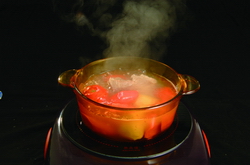
- Safe Temperature
Cooked and perishable food should be kept in a refrigerator within two hours after purchase.
A thermometer should be used to measure the temperature of the refrigerator to ensure that the fridge is kept at or below 4oC and the freezer is kept at or below -18oC.
Cooked food if not properly stored is prone to deterioration and conducive to bacterial growth. Hence, food should be consumed immediately after cooking and should not be kept at room temperature for more than two hours. Cooked food not intended for immediate consumption should be kept above 60oC.
Implementing the "5 Keys to Food Safety" is easy in your daily life. Food is more enjoyable if it is safe. By following the "5 Keys to Food Safety", food safety is in your hands.
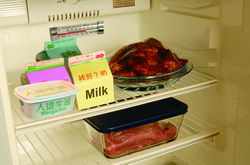
II. Enjoying "Poon Choi" in Winter
Winter is the perfect time for enjoying "poon choi". As "poon choi" comprises a great variety of food ingredients and the preparation involves a number of processing steps and takes a relatively longer time, cross contamination is more likely to occur. Therefore, people should pay extra attention when purchasing or preparing "poon choi" to ensure food safety.
Points to Note When Purchasing "Poon Choi":
- Purchase "poon choi" from reputable and licensed suppliers. Do not patronise unlicensed suppliers;
- Apart from the ingredients and the price, customers should ask the supplier the followings before ordering "poon choi":
- how the temperature of the "poon choi" is maintained after preparation (Avoid keeping "poon choi" at room temperature for a prolonged period of time after preparation. "Poon choi' should either be kept at or below 4 oC, or kept above 60 oC);
- whether the customer needs to reheat the "poon choi" and if so, how it should be reheated;
- whether the original container of the "poon choi" can be used for reheating;
- Notify the supplier of the time you collect the "poon choi" when making an order so that the supplier will not prepare the "poon choi" too early;
- Avoid picking up the "poon choi" too early. Insulating equipment should be used during transportation to avoid keeping the "poon choi" at room temperature for too long. Prolonged storage at room temperature favours bacterial growth, thus increasing the risk of food poisoning;
- Check with the supplier if you have doubt about the temperature at which the "poon choi" is delivered or stored.
Points to Note When Preparing "Poon Choi"
- Buy ingredients from reputable suppliers;
- Since a lot of ingredients and cooking utensils are involved in the course of preparing "poon choi", a well-organised work schedule can help prevent cross contamination and avoid preparing "poon choi" too early;
- Thaw frozen food in the fridge or under running water;
- High risk food such as seafood and meat should be thoroughly cooked;
- If the ingredients need to be stored after cooking, they should either be kept above 60 oC or chilled as quickly as possible and then kept at or below 4 oC;
- Raw and cooked food should be properly covered and stored separately in a refrigerator to prevent cross contamination. Keep cooked food above raw food;
- Use different sets of utensils that can be easily identified (e.g. in different colours) to handle raw and cooked food separately;
- All food contact surfaces such as dining utensils, cutting boards and cooking utensils should be cleansed and sanitised thoroughly before preparing "poon choi";
- Maintain good personal hygiene. Stop handling food if you have symptoms of infectious diseases like gastroenteritis and flu;
- Wash hands thoroughly with warm water and liquid soap before handling food, after going to the toilet or touching dirty things (such as disposing of refuse);
Points to Note When Consuming "Poon Choi"
- Consume the "poon choi" as soon as possible after it is collected or cooked. Do not keep it at room temperature for more than two hours;
- Use communal chopsticks and spoons when consuming "poon choi". Consume the food in one go to ensure food safety;
- If irregularities such as abnormal taste or smell are detected, stop consuming the food immediately and contact the supplier or the Food and Environmental Hygiene Department (FEHD) as soon as possible.
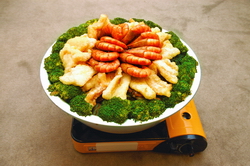
III. Observe good hygiene practices when enjoying hotpot
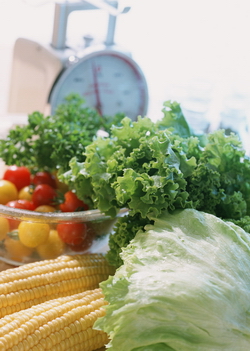
As the weather is getting cold, many people in Hong Kong love to gather around the table to enjoy hotpot. With various ingredients, including meat, vegetables and seafood such as shellfish and raw oysters, hotpots are served with different "soup bases" and condiments. Food in hotpot is indeed savoury. There are, however, potential risks in enjoying hotpot. If the food is not handled properly or not thoroughly cooked, it may contain pathogens such as Escherichia coli, Vibrio cholera, Vibrio parahaemolyticus, Norovirus, Hepatitis A virus and parasite larvae, which may cause food poisoning or other intestinal infection.
Therefore, when we have hotpot in a restaurant or at home, we must follow the "Five Keys to Food Safety" to minimise the risk of getting sick.
- Purchase fresh ingredients
- Buy ingredients from reputable licensed shops; patronise reputable licensed restaurants.
- Check whether the food is fresh, packaging is intact and read the food labels on the packages, to avoid buying contaminated or expired food items.
- Check whether the container and the water for holding seafood are clean. Do not buy any shellfish with abnormal odour or whose shells are not intact.
- Store food in suitable environment and at appropriate temperature
- Fresh hotpot ingredients should be put in a clean container with cover and stored in a refrigerator at or below 4 o C until they are to be consumed.
- Never thaw food at room temperature to prevent bacterial growth. Frozen food should be thawed in fridges or microwave ovens before cooking.
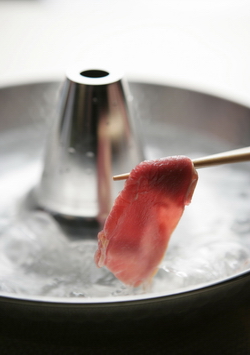
- Keep food, utensils and hands clean
- Wash all food ingredients thoroughly before consumption. Vegetables should be washed and then soaked in clean water for about an hour before cooking.
- Handle shellfish with care. Scrub and wash the shells and keep them in clean water for at least half a day to allow self-purification, and remove their internal organs before cooking.
- Observe good personal hygiene. Wash hands thoroughly with liquid soap and warm water before and after handling food, and after going to the toilet.
- Bowls and dishes that have been used for holding raw food must be thoroughly cleaned and sanitized before reuse.
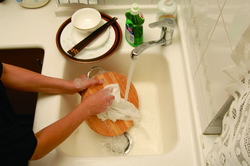
- Handle raw food and cooked food separately
- Use two separate sets of chopsticks and
- utensils to handle raw food and cooked food to avoid cross contamination.
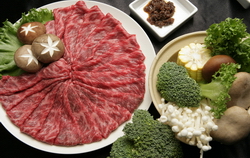
- Cook food thoroughly
- Fish and meat should be cut into thin slices. Meatballs should be cut open in the centre to speed up heating.
- Remove the shells of shellfish before cooking so that it is easier to cook shellfish thoroughly.
- Wait until the "soup base" is boiling before putting the food into the pot. After water has been added into the pot, wait until the "soup base" boils again before cooking the food.
- Cook food thoroughly before consumption. High risk food such as seafood should be cooked in boiling water for at least five minutes.
- Do not eat raw eggs or cooked food in sauces mixed with raw eggs to avoid Salmonella food poisoning.
IV. Know More about Desiccant
To preserve quality, control humidity, minimise mould growth and extend shelf-life, desiccants are added to the packaging of many pre-packaged food in the market, such as ready-to-eat seaweeds, biscuits or pastries. Two most commonly used desiccants are silica gel and calcium oxide.
Silica gel / silica dioxide is a natural mineral which changes to molecular or bead form after purification and processing. It is chemically and biologically inert. Therefore, no harmful health effects will be caused even if they are accidentally ingested in small amount.
Calcium oxide, also called quicklime, is a white powder which can control humidity effectively by keeping the relative humidity below 10%. It is widely used for packaging dehydrated foods or foods that need to be stored in environment with low humidity (e.g. biscuits or pastry food). In contact with moisture, calcium oxide becomes caustic and may cause burning sensation, stomach cramps and diarrhoea if swallowed accidentally.
Other desiccants include activated carbon, clay and calcium chloride, etc. They are less commonly used due to higher cost.
There are occasional incidents of accidental consumption of desiccants. Members of the public should therefore pay attention to the potential hazards of desiccants. They are advised to discard the sachet of desiccant once the food packaging is opened to avoid accidental consumption by the elderly and young children, and to discard the food with the packaging at once if the sachet of desiccant is found broken.
V. Melamine in Mainland's Milk Powder Incident
In September 2008, cases of kidney stones affecting infants who had consumed melamine-tainted infant formula were reported in the Mainland. Such cases gave rise to grave public concern. The Mainland authority subsequently announced that a number of infant formulae made and sold in the Mainland were found to contain melamine, with the Sanlu brand having the highest level (up to 2 563 ppm), and that melamine at this level may affect the elimination of this chemical from the infant's body and result in kidney diseases, including the development of urinary stones.
Even though Sanlu infant formula was not available in Hong Kong , follow-up actions undertaken by the Centre for Food Safety (CFS) found melamine in a number of milk and milk products available in Hong Kong . To safeguard public health and safety, CFS has been conducting food tests actively and announced the latest information through press releases and the CFS web site. A hotline has also been set up to answer public enquiries.
What is Melamine?
Melamine is an industrial chemical used for the production of melamine resins, which are used in glues, paper, textiles as well as plastics including tableware, kitchen utensils, etc. Apart from the potential adulteration of food, exposure to melamine for the general population has been considered to be low. Use of melamine as a food ingredient or a food additive is strictly forbidden in all countries. However, some people added melamine to foods in the manufacturing process to cause a false increase in the measurement of protein during protein tests by boosting their nitrogen levels.
Health Effects of Melamine
Melamine has low oral acute toxicity. However, excessive exposure to melamine has been found to cause urinary stones in experimental animals. Also, laboratory studies showed that melamine did not damage genetic materials in cells, and there was inadequate evidence to show that melamine can cause human cancers or malformation in foetus. However, intake of a significant amount of melamine can cause crystal formation in urinary tract. In severe cases, these crystals can form kidney stones, blocking the small tubes in the kidney, stopping the production of urine, causing kidney failure and death in some serious cases.
Infants are particularly vulnerable and at risk of developing adverse health effects as a result of consuming melamine tainted milk-products because milk is their major food, and the amount of melamine intake per body weight is much higher than that of adults who consume a variety of foods. According to the epidemiological information obtained from the Mainland, over 99% of the victims were children aged 3 years or below. Affected children may experience symptoms of irritability of unknown reasons, blood in urine, little or no urine (in case of acute renal failure), stones in urine, high blood pressure, or pain over the kidney region.
Safe Intake Level of Melamine
Melamine can be present in the environment as a metabolite of the pesticide cyromazine. Traces of melamine may be present in food due to environmental contamination or through migration of melamine from food-handling utensils made of melamine. Therefore, the "zero tolerance" approach is not applicable to melamine.
Under the amended Harmful Substances in Food Regulation (Cap. 132AF), milk, any food intended to be consumed principally by children under the age of 36 months and any food intended to be consumed principally by pregnant or lactating women shall not contain melamine exceeding 1 mg/kg. For other foods, the melamine level shall not exceed 2.5 mg/kg. The legal limit adopted in Hong Kong is based on risk assessment and is stringent enough to protect the health of both children and adults. With normal food intake, even if all the foods consumed each day by a person contain melamine, provided the melamine levels in all the foods comply with the legal limit, the foods would still be safe.
Surveillance and Support Action of CFS
Since September 2008, the CFS has been testing various infant formulae, milk, milk products and other food products (including fresh milk, ice-cream, ice-lolly, yogurt, baby food, nutritional supplements, instant drink mixes, biscuits, cakes, bread, chocolate and candies etc.) for melamine. The CFS has, on the recommendation of the Expert Group on Melamine Incident, expanded the food sampling plan to include food raw materials (e.g. eggs), meat and vegetables in the second phase of testing. Upon the conclusion of the second phase of testing on November 16, CFS has entered into the third phase since 17 November, in which samples of food types found unsatisfactory in the previous two phases have been retaken for testing.
The latest results on the testing of food samples are available at the following web page:
http://www.cfs.gov.hk/english/whatsnew/whatsnew_fstr/whatsnew_fstr/melamine_result.html
Advice to Consumers
- Consumers are understandably concerned about the possible adverse health effects associated with the consumption of the affected products. Nevertheless, there is no cause for undue alarm.
- If food products have melamine levels exceeding the legal limits, consumers should not consume them.
- Adverse health effects are unlikely after normal consumption of foods meeting the legal limits.
- Children should seek medical advice if they have urinary symptoms including the development of urinary stones and with history of prolonged exposure to melamine contaminated dairy products.
Readers' Corner
Hazards of Seafood, Sushi and Sashimi - Vibrio Parahaemolyticus
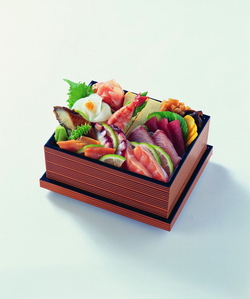
Delicious foods from all over the world are available in Hong Kong , which is reputed as a fine dining hub. Seafood has always been a favourite of Hong Kong people. Sushi and sashimi, known for their freshness, have been very popular in recent years. These foods, however, pose hazards to our health despite their good taste. Seafood may contain Vibrio parahaemolyticus, and will easily cause food poisoning if not handled properly. Members of the public should pay extra attention in the preparation or consumption of these foods to prevent diseases.
Vibrio parahaemolyticus as a cause of food poisoning
Vibrio parahaemolyticus is a halophilic vibrio often found in the marine environment and seafood. This bacteria is highly reproductive. They can breed exponentially in room temperature of 18 ° C to 22 ° C in a few hours, and are one of the common causative agents of food poisoning. Consumption of seafood (in particular shellfish) that has not been thoroughly cooked may cause bacterial infection.
One may develop symptoms including diarrhoea, vomiting, mild fever and abdominal pain, etc. usually within one to two days of being infected. They can recover after replenishing with water and electrolyte together with adequate rest. However, young children, the elderly or persons suffering from gastric diseases will easily get dehydrated upon infection. In this case, antibiotics treatment may be required.
Vibrio parahaemolyticus can be destroyed by heating at or above 75 ° C continuously for 30 seconds. Therefore, the best way to prevent food poisoning is to cook food thoroughly.
Advice to public:

Choose fresh foods
- Patronise licensed and reputable shops.
- Pay attention to the colour and odour of food (Do not consume any food that is pale-coloured or with a foul smell).
- Pay attention to the expiry date, do not consume expired foods.
Keep clean
- Observe personal hygiene, always wash hands before preparing food, eating and after going to the toilet.
- Handle raw and cooked food separately
- Observe food hygiene to prevent cross contamination of raw and cooked food.
- Cook food thoroughly
- Seafood must be cleaned and cooked thoroughly.
Keep food at safe temperature
- Sushi and sashimi are foods with short shelf-life. For takeaway, the food must be properly chilled during transportation and in storage. Consume the food soon after purchase and do not leave it at room temperature for a long period.
If sick after consumption, consult a doctor as soon as possible and contact the Food and Environmental Hygiene Department (FEHD).
Food News
Dietary fibre
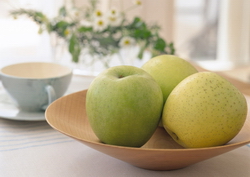
This issue focuses on a food nutrient called dietary fibre, i.e., the item recommended for a "High" intake in the healthy eating campaign of "3 Low, 1 High" launched in recent years. Dietary fibre is mainly obtainable from vegetables, fruits, whole grain cereals and their products, and legumes, etc. Dietary fibre can be divided into soluble fibre and insoluble fibre. Although neither is absorbed directly by human body, both are indispensable to health. The questions and answers below can help you understand more about dietary fibre.
Q1: Which one of the two dietary fibres is more important to human health?
A1: Both of them are beneficial to our health in their own way. Insoluble fibre (mainly from whole grain cereals and vegetables) helps to stimulate intestinal movement, facilitates defecation and promotes intestinal health, whereas soluble fibre (mainly from fruits, beans and oatmeal) helps to lower blood cholesterol level and stabilise blood sugar level. Increased consumption of foods rich in dietary fibre may provide other health benefits such as weight management. In this way, we can kill many birds with one stone.
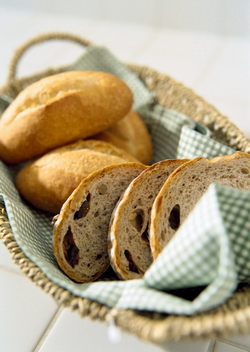
Q2: What is the adequate daily intake of dietary fibre?
A2: The World Health Organisation recommends a daily intake of not less than 25g of dietary fibre for an average adult, and a daily consumption of 400g (about 10 taels) or above of vegetables and fruits for an individual to lower the risk of obesity and certain cardiovascular diseases. On top of taking enough dietary fibre, don't forget to drink enough water (about 6 to 8 glasses daily) as a complement!
Q3: How can the daily intake of dietary fibre be increased?
A3: We should choose cereals and cereal products with high dietary fibre content, for example, red rice / brown rice instead of white rice; whole wheat bread instead of white bread; oatmeal porridge instead of congee, etc. In addition, we should have two servings of fruit and three servings of vegetables each day. Do note that the content of dietary fibre in fruits and vegetables will be reduced if they are peeled or turned into juices.
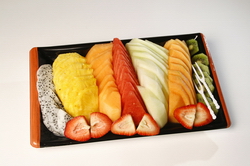
Critical Control Point of Preparing Steamed Plain Chicken (For Consumers)
Hong Kong people usually get together to have a meal at home in celebration of traditional festivals. Among others, chicken is an indispensable item on the menu. Steamed plain chicken is, in particular, the most popular because it is easy to prepare. It is a kind of poached chicken and you need to pay attention to some critical points on safety during preparation. Therefore, we will provide some useful safety tips in preparing steamed plain chicken, so that you and your family can enjoy it safely.
Ingredients
| 1 raw chicken…………….. | 1.2 kg (about 2 catties) |
|---|
Steps
- Rinse the chicken.
- Soak the whole chicken in boiling water. Then switch to low heat and stew the chicken for about 30 minutes.
- Cool the poached chicken and chop it for serving .
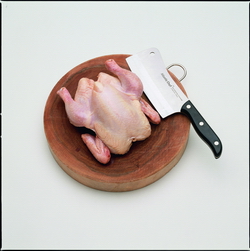
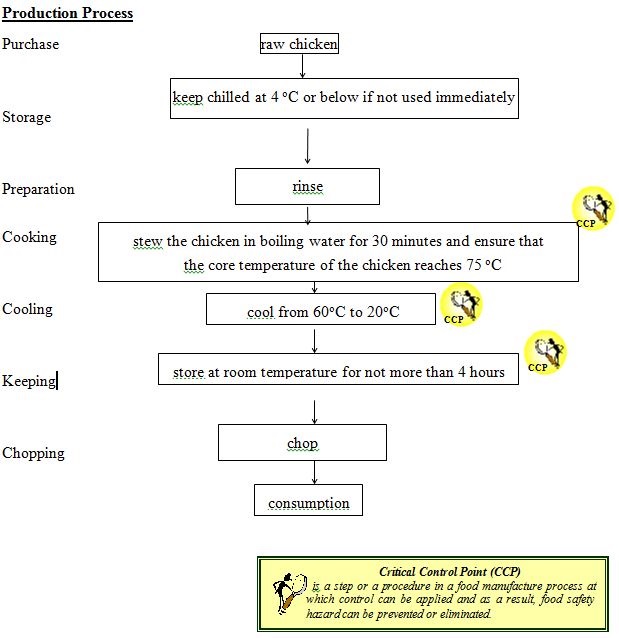
Safety Tips on Production of Steamed Plain Chicken
- Purchase
- Purchase raw chicken from a reliable and hygienic shop.
- When buying raw chicken, make sure that it is fresh and wholesome.
- Storage
- Store the chicken immediately at safe temperature
- If the chicken is not for immediate preparation, it should be properly covered and stored in the refrigerator . It should be put under cooked food or ready-to-eat food to prevent cross-contamination . The temperature inside the refrigerator should be checked regularly with a thermometer to ensure that the fridge remains at 4 oC or below.
- Preparation
- Before cooking / during preparation, wash hands thoroughly with warm water and liquid soap.
- Before cooking, rinse the chicken.
- Cooking
- The c hicken should be thoroughly cooked before consumption. When the chicken is cut, its meat juice should be clear and not red, and blood is not visible.
- Use a clean food thermometer to measure the core temperature of the thickest part of steamed plain chicken to ensure that it reaches at least 75 oC. (CCP)
- Cooling
- Cool the steamed plain chicken from 60 oC to 20 oC within 2 hours. (CCP)
- Use potable water to cool the steamed plain chicken.
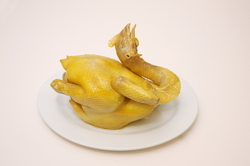
- Chopping
- Before and after handling food, wash hands thoroughly with warm water and liquid soap.
- Before and after handling food, rinse all food contact surfaces (including worktops, chopping boards, utensils, etc.) thoroughly.
- Use two different sets of tools (including knives and chopping boards) for handling raw food and cooked food.
- Keeping and consumption
- Do not keep the steamed plain chicken at room temperature for more than 4 hours. (CCP)
- If the steamed plain chicken has been held at room temperature for less than 2 hours, it should be refrigerated or used before the 4-hour limit is up.
- If the steamed plain chicken has been held at room temperature for 2 to 4 hours, it should be consumed within the 4-hour limit but it should not be returned to the refrigerator.
- If the steamed plain chicken has been held at room temperature for more than 4 hours, it should be discarded.
Briefing of Activities
Interviews with signatories of the Food Safety Charter
With a view to setting a good example for the food trade to help build a food safe city, the Centre for Food Safety (CFS), in its publicity campaign to promote the "5 Keys to Food Safety" in mid-2008, invited food trade associations and licensed food premises to sign the Food Safety Charter. The response is encouraging with a total of 20 food trade associations and over 1 500 food premises having signed the Charter as at 1 st of November.
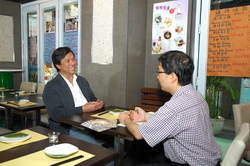
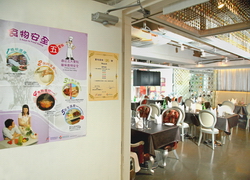
One of the signatories, Mr CHE, said that apart from price and taste, the hygienic condition of food premises was also one of the major customers' concerns. Food hygiene and food safety, therefore, had been the focus of his Japanese restaurant well before he signed the Charter. Shortly after learning of this CFS campaign, Mr CHE enrolled to become one of the first signatories and encouraged active participation within his association. He found the 5 Keys to Food Safety – Handbook for Trade published by the CFS for this campaign very useful in educating his staff about food safety.
Mr CHE was a "hands-on" person. He went to the market and made purchase by himself every two to three days. He emphasised that food ingredients must be purchased from reliable and reputable suppliers. He would educate his staff on proper food safety practices and arrange for them to receive training on the "5 Keys to Food Safety", so that they could be familiar with the food preparation steps and recognise the importance of food safety.
He always reminded his staff to purchase fresh and wholesome food ingredients, check their quality upon receipt, reject dubious items, and, in the course of food preparation, ensure food safety to avoid problems arising from the food. He considered this a long term solution to reducing production cost in addition to minimising raw material wastage and product recall.
As a catering operator for over 20 years, Mr CHE had been striving to provide quality customer-oriented services. He always encouraged his staff to apply the "5 Keys to Food Safety" in their daily work, so that customers would be impressed not only by the cuisine but also their sincerity in promoting food safety. As Mr CHE said, the financial tsunami had made customers more prudent in spending; food business operators had to be more conscious of food safety and quality in order to stand out in the industry.
Another signatory, Mr WONG, considered that strict compliance with food safety rules was the key to customers' confidence, not only because Hong Kong was a world-class metropolis, but also because both local and overseas were expecting more from what they eat. As a professional catering operator who ran a renowned western restaurant, Mr WONG said that apart from enhancing the image of the restaurant, more importantly, signing the Charter helped to disseminate food safety messages to his staff and customers. His enthusiasm for promoting food safety was well-evidenced in the kitchen of his restaurant where the "5 Keys to Food Safety" posters could be seen all over the walls as a regular reminder to his staff. To Mr WONG, staff training was very important. He never missed the annual food hygiene seminar held by the Government and arranged for his staff to attend whenever possible in the hope that they could refresh their food safety knowledge and share new information with their colleagues.

Mr WONG opined that the key to become a more reputable restaurant was enhanced environmental hygiene and food afety management. Customers naturally patronised more if they had confidence in a restaurant. He appealed to the trade to attach greater importance to food safety and join hands in keeping Hong Kong a food paradise.
The signatory list can be found in the following web site (for ease of reference, food premises are listed by name, district and type of cuisine):
Legal Corner
I. Regulations on Melamine
In response to recent incidents of melamine found in dairy products of Hong Kong and the Mainland, the Government took contingency actions and amended the Harmful Substances in Food Regulations (Cap. 132AF), which has already come into operation, to safeguard public health.
Under the Regulations, milk, any food intended to be consumed principally by children under the age of 36 months and any food intended to be consumed principally by pregnant or lactating women shall not contain melamine exceeding 1 mg/kg. For other food, the melamine level shall not exceed 2.5 mg/kg. "Milk" means cows milk, buffaloes milk and goats milk, and includes cream, separated milk and milk beverage, but does not include dried milk, condensed milk or reconstituted milk; "milk beverage" means any beverage resulting from combining liquid milk fat with other solids derived from milk, whether exclusive of any food additive or otherwise.
According to the amended Regulations, any person who imports, consigns, delivers, manufactures or sells food with melamine concentration that exceeds the statutory limit commits an offence.
II. The Public Health and Municipal Services (Amendment) Bill 2008
There is an increasing number of food incidents happening all over the world and food safety is a concern of the general public. The food trade has the responsibility to ensure that the food they supply is safe and fit for human consumption. They also have the responsibility to stop supplying problem food to the market and recall problem food that has already been supplied to protect the health of consumers.
In view of this, on October 24, the Government gazetted the Public Health and Municipal Services (Amendment) Bill 2008, which proposed to empower the Director of Food and Environmental Hygiene (DFEH) to make orders administratively to prohibit the import and supply of problem food, and direct that problem food supplied be recalled, to ensure food safety and protect public health. The Bill was submitted to the Legislative Council on November 5.
Under the Public Health and Municipal Services (Amendment) Bill 2008, DFEH may make orders administratively if he has reasonable grounds to believe that the making of the order is necessary to prevent any danger to public health.
DFEH will take into consideration the following factors in deciding whether to make the order:
- Information or document provided by the food traders, if any, on the safety of the food;
- results of food tests conducted by the Public Analyst, if available;
- results of food tests conducted by food safety authorities of other countries or places;
- food alerts issued by food safety authorities of other countries or places;
- time required for conducting the food test;
- the exposure of the general public and/or particular vulnerable groups to the food;
- consumption pattern relating to the food;
- statutory standard of the concerned substances in the food, if any;
- availability of information on the contamination of a particular batch or consignment of the food;
- availability of information on the contamination of a particular food factory or the whole region; and
- any other relevant considerations.
Given that more than 90% of the food in Hong Kong is imported, a prohibition of import order is a highly effective and direct measure for stopping problem food from entering the Hong Kong market.F
or the latest information on the Public Health and Municipal Services (Amendment) Bill 2008, please visit http://www.fhb.gov.hk/.